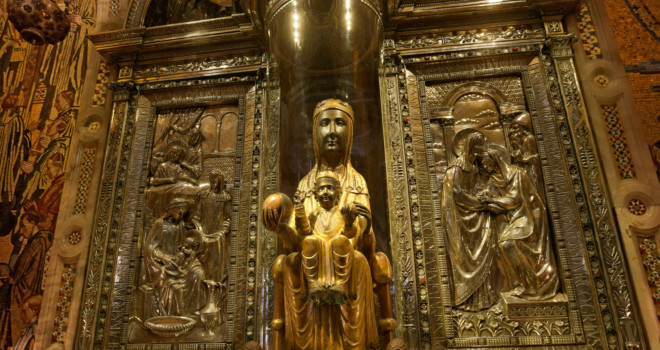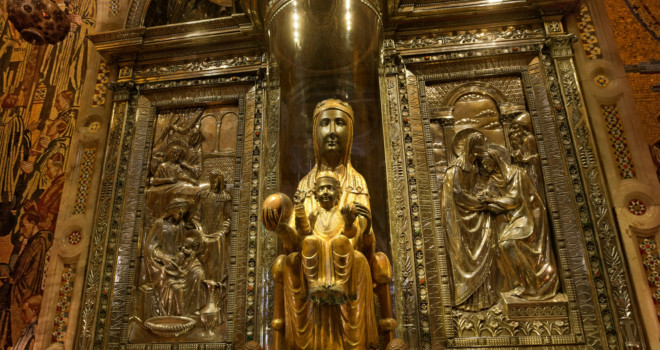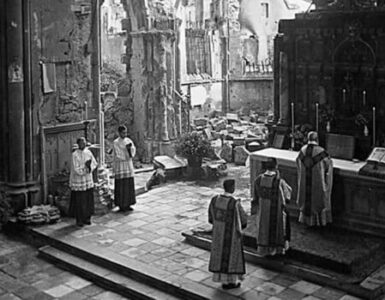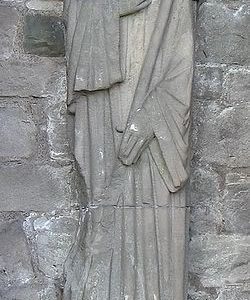Part II
Montserrat, the “serrated mountain”, near Barcelona in Spain symbolizes the vital power of the Church. Even after seemingly hopeless periods of decline, Our Lord leads her back again to her mission of salvation far beyond all known boundaries. What will the Marian shrine of La Moreneta on Catalonia’s Holy Mountain teach us today? Mysteriously, Our Lady of Montserrat brought the faith even to the New World. For it was the hermit Bernat Boïl (1440/45-1507/9) of Montserrat who accompanied Christopher Columbus (1451-1506) on his second voyage and planted devotion to La Moreneta in the soil of the newly discovered continent. On January 6, 1494, he said the First Holy Mass in the New World in La Isabela, the first Christian settlement of the Americas.
La Moreneta Inspiring Counter-Reformation
Passing through the gate, one sees a statue of Ignatius of Loyola (1491-1556), who in 1522, as a young hidalgo and Don Juan in his own way, laid his arms at the feet of La Moreneta after a night of prayer and was clothed by her with spiritual arms. “In the evening, on the eve of our Lady of March [Annunciation], in the year 1522,” Ignatius was to write of himself in his autobiography, “he went to kneel before the altar of our Lady. And some times in this way, and other times standing, with a stick in his hand, he spent the whole night.” (A Pilgrim’s Journey, 1547) Secluded in a cave near Manresa, the grandiose castle of Montserrat before his eyes, Ignatius wrote his Ejercicios espirituales, Spiritual Exercises, inspired by the Ejercitatorio de la vida epiritual of the reform abbot García Ximenes de Cisneros (1455/56-1510).
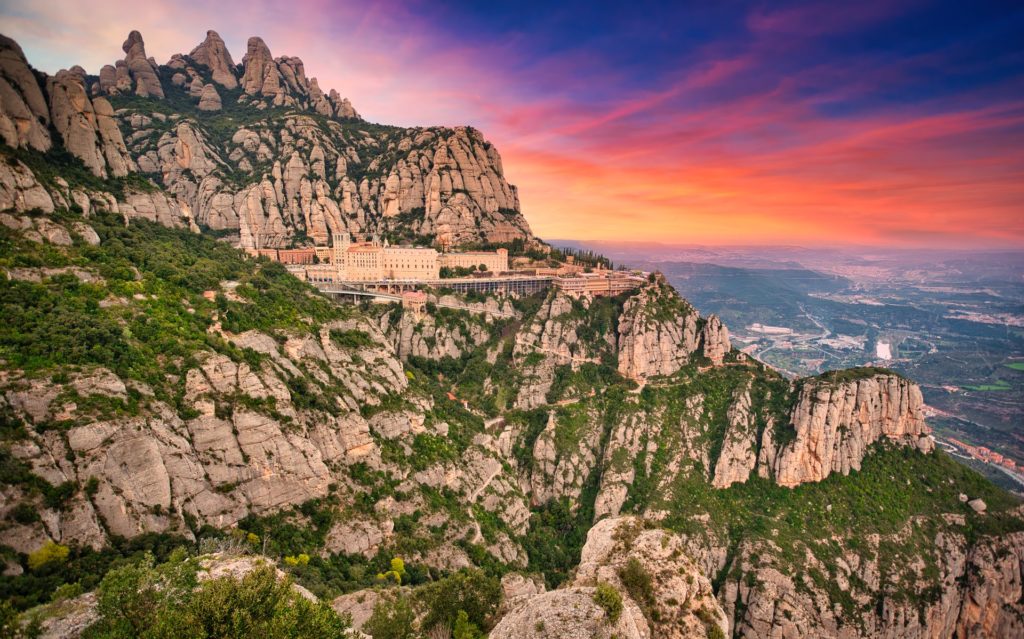
Cisneros was the spiritual teacher of the Benedictine monk Jean Chanons OSB, who heard Ignatius’ three-day general confession. Already in the year 1500, this work appeared in print on Montserrat. The German master printers Johann Luschner and Johann Rosenbach von Hayn established the long tradition of book printing on Montserrat. Abbot Cisneros himself was influenced by the devotio moderna around Thomas a Kempis (c.1380-1471) and his Imitatio Christi, which still accompanies many people today. For the holy statesman and martyr Sir Thomas More (1478-1535), the Imitatio Christi was one of the three books that everyone should possess.
The Ignatian Exercises are thus a gift of La Moreneta and make the spiritual tradition of Montserrat fruitful for the whole world. Even Friedrich Nietzsche (1844-1900), a prophet of modernity rather than its philosopher, confesses his “being strongly struck by the figure of St. Ignatius of Loyola”.
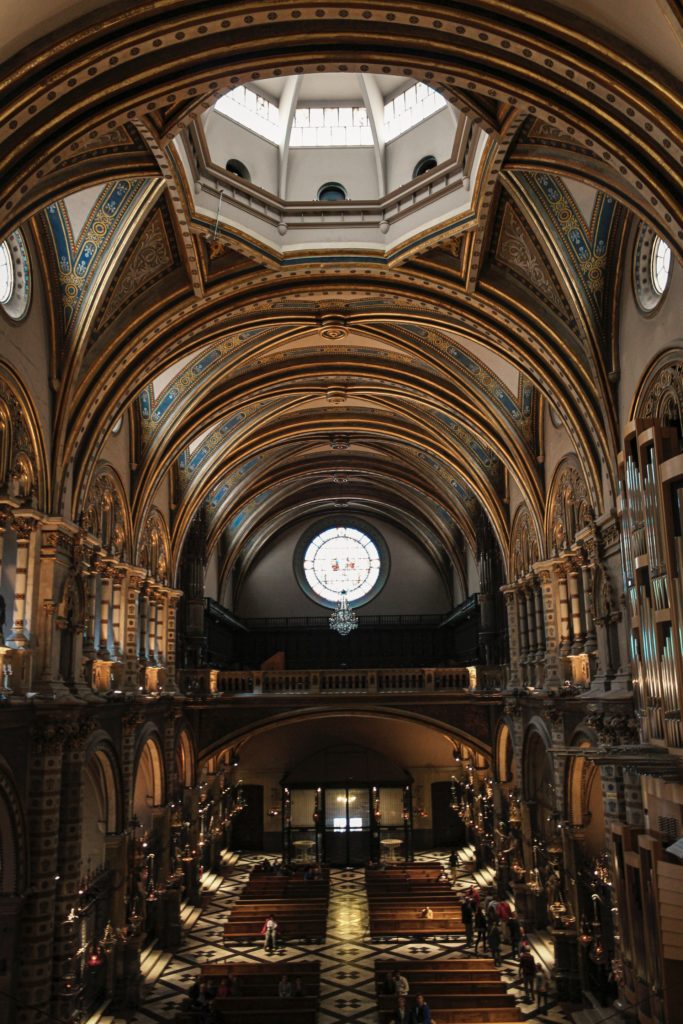
Francisco de Paula Vallet y Arnau (1883-1947), a Catalan Jesuit conceived a five-day retreat that continues to form lay people through the treasure of the Ignatian Exercises. Vallet makes it a powerful instrument of popular piety and spreading the social kingship of Jesus Christ, but without sacrificing its spiritual substance. From 1923 to 1927, more than 12,000 people participated in these exercises in Catalonia, many of whom became martyrs in the Spanish Civil War. In 1928, Vallet founded the Congregation of Cooperators of Christ the King in Parishes (Congregatio Cooperatorum Paroesialium Christi Regis, CPCR) to renew spiritual life even outside Catalonia. The missionary Jean-Jacques Marziac CPCR (*1924) opened up the renewing power of Vallet’s five-day exercises for the present, which prove particularly fruitful in combination with the traditional Latin Mass.
“Among all the methods of Spiritual Exercises,” teaches Pope Pius XI (1857-1939) in his encyclical Mens nostra of December 20, 1929, “one has ever held the foremost place and adorned by the full and repeated approbation of the Holy See and honoured by the praises of men, distinguished for spiritual doctrine and sanctity […]. We mean the method introduced by St. Ignatius of Loyola, whom we are pleased to call the chief and peculiar Master of Spiritual Exercises.”
A fresco from 1957, created by the painter and sculptor Francesc Fornells-Pla (1921-1999), in the passageway to the atrium in front of St. Mary’s Church commemorates Don Juan of Austria (1547-1578), the brave and pious hero of Lepanto, as he consecrates victory trophies of the Turkish admiral’s ship to La Moreneta. Even today, the Feast of the Rosary celebrates the naval victory of October 7, 1571, which contemporaries experienced as an unimaginable miracle of grace. Even the cultural consciousness links Lepanto to the help of La Moreneta, for example by Titian’s painting of the battle in the Prado, Madrid, and Veronese’s in the Academia Reale, Venice.
For Emperor Charles V (1500-1558), the father of Don Juan de Austria, Montserrat becomes the mountain of the Counter-Reformation. It was here, where the delegation of the German Prince Electors laid the imperial crown at his feet. In in prayer before La Moreneta he made the decision to resist the Protestant reformers; from here, he set out for the Diet of Augsburg in 1530; from here, he went to the Schmalkaldic War. Centuries later, Titian’s painting showing him as the victor of the Battle of Mühlberg in 1547 in the Prado would prove moving for the first German Chancellor, the Catholic Konrad Adenauer (1876-1967).
When Charles died in the monastery of San Jerónimo de Yuste in the solitude of Extremadura, he held in his hand a candle from Montserrat that his son Philip II (1527-1598) had revered so much that his father’s half-burned funeral candle accompanied him on all his travels. “He held the candle of Our Lady of Montserrat so tightly in his hand at his death that it was almost impossible to remove it after his death,” recalled an eyewitness of Philip’s death in the Escorial.
During the Thirty Years’ War between Catholics and Protestants in Europe, La Moreneta repeatedly became an aid against the Swedish King Gustav Adolf (1594-1632) and his cruel Protestant troops. A considerable part of the trophies of victory, especially the standards of Gustav Adolf’s regiments, are dedicated to her and can still be seen. All Austrian emperors were benefactors of Montserrat until the Josephine period.
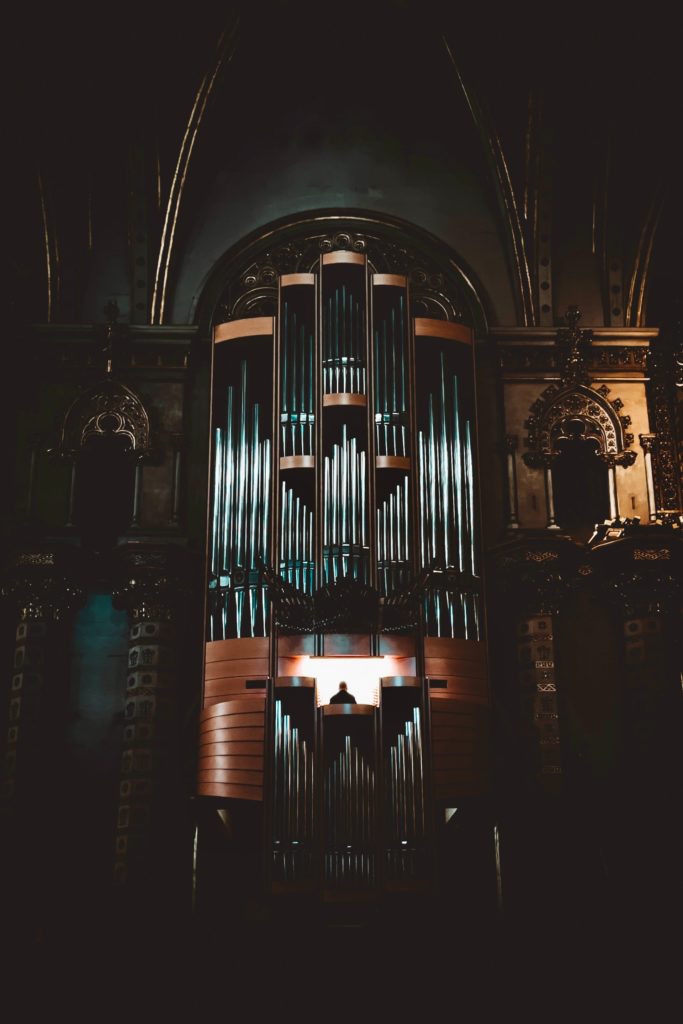
Montserrat and the Renewal of Sacred Music
The atrium gathers the pilgrims who strive in long line and in silent prayer to La Moreneta. This also gives our travelers time to contemplate sgraffiti from the 1950s on the walls. They were executed according to the designs of Josep Obiols (1894-1967), who also created the frescoes in the sacristy, the refectory, the Marian choir and the abbey room. The travelers first observe the motto of Pope Pius X (1835-1914), canonized in 1954: OMNIA INSTAURARE IN CHRISTO – Restore All Things in Christ. An inscription calls him DISCIPLINAE ECCLESIAE INSTAURATOR. The extent to which his pontificate of reform is connected with the renewal of sacred music is shown by sgrafitti to the left and right of a statue of another holy pope, Gregory the Great (c.540-604).
The name Dom Prosper Guéranger OSB (1805-1875) recalls the founder of the liturgical renewal since the middle of the 19th century. The re-founded abbey of Saint-Pierre de Solesmes, where he was the first abbot, became the spiritual mother of renewed Benedictine congregations in numerous countries. A second name is Dom André Mocquereau OSB (1849-1930), who continued Dom Guéranger’s work. In the USA, the Congregation of Solesmes is present through the Benedictine Sisters of The Monastery of the Immaculate Heart of Mary, Westfield, VA, and the Benedictines of Our Lady of Clear Creek Abbey, Hulbert, OK. Two other names on the right recall the ecclesiastical-musical renewal that emanated from Montserrat itself, Gregori Maria Sunyol i Baulenas OSB (1879-1946) and Lluís Carreras i Mas (1884–1955).
Sunyol was a Benedictine monk and musicologist committed to the school of Solesmes (The Textbook of Gregorian Chant According to the Solesmes Method, Kessinger Publishing 2010). In 1938, Sunyol became director of the Pontifical Institute of Sacred Music and a little later abbot of the Cecilia Monastery on Montserrat. A significant achievement of Sunyol is his research on and editing of Ambrosian sacred music. In the 10th book of his Confessiones, St. Augustine (354-430) recalls the tears “that I shed at that time, in the first period of my return to the faith, singing the songs of Your Church.” In the Easter Vigil of 387, St. Ambrose (c.340-397) himself had baptized him.
Even today, the Oriental-sounding chants of the Milanese tradition, such as the Gradual of the XXII Sunday after Pentecost, Ecce quam bonum et quam iucundum habitare fratres in unum, is touching. Listen to it here. Ambrose’s popular Advent hymn Veni redemptor gentium was translated by John Mason Neale (1818-1866), “Come, Redeemer of the nations”, often sung to the tune Puer nobis nascitur by Michael Praetorius (1571-1621). Because of his closeness to the Oxford Movement, Neale was cold-shouldered in Anglican England and received his doctorate from Trinity College in Hartford, CT. The Ambrosian melody, however, reaches straight to the heart.
May Ambrosian Chant, rediscovered from Montserrat, be today a key to Islamic hearts? Isn’t it providential that Our Lady appeared in 1917 in village named after a Moorish prince’s daughter baptized in 1158? Fatima was the name of Mohammed’s daughter, called “mistress of the women among the inhabitants of the world.” Only her descendants survived, her burial place being unknown. In the Shiite Islam, Fatima is one of the “Fourteen Infallibles”, the only woman with Muhammad and the Twelve Imams. “Whoever thinks that the prophetic mission of Fatima has ended is mistaken,” admonished Benedict XVI (b.1927) at Fatima on May 13, 2010. A key to Islamic minds could be Aquinas, who took up Persian and Arabic commentators of Aristotle, such as Avicenna – Ibn Sīnā (980-1037) – and Averroës – Ibn Ruschd (1126-1198).
Dom Sunyol was in close contact with the American Justine Ward, née Cutting, (1879-1975). The daughter of William Bayard Cutting (1850-1912), a New York’s merchant aristocrat and among the founders of the Metropolitan Opera, developed an American method of early musical education before the Hungarian Zoltán Kodály (1882-1967) and the German Carl Orff (1895-1982). Ward’s approach contributed significantly to the worldwide dissemination of Pius’ X liturgical and musical reforms (The Reform of Church Music, The Atlantic Monthly, April, 1906; A. A. Brown, Justine Ward: Her life, her method in comparison to Orff and Kodaly, and applications for the public school classroom. University of Northern Colorado 2007). What a loss is the displacement Gregorian Chant from the lives of the laity today!
Montserrat also influenced Lluís Carreras i Mas (1884-1955), ordained priest in 1909, who was also a writer, journalist and promoter of the religious renewal movement in Catalonia before the Civil War. In 1913, he served as the secretary of a Congress of Christian Art of Catalonia and organized the 1st Liturgical Congress in Montserrat in 1915. Later he becomes the driving force of the Amics de lʼArt Litúrgic, whose activities are based on the motu proprio of Piusʼ X on sacred music of 1903. The “Friends of Liturgical Art” were part of the St. Luke’s Circle of Artists, founded in 1922 with the aim of promoting a modern religious art related to the needs of the liturgy. Antoni Gaudí belonged to this movement. Aureli Maria Escarré, the abbot of Montserrat, read the Requiem for Carreras and buried him.
✠
Editor’s note: This article is the first part in a three-part series, “The Mystery of Montserrat.” You can read future parts of this series each Friday or subscribe to Catholic Exchange’s email list to receive future articles.
Dorothea and Wolfgang Koch have also contributed two previous in-depth series for Catholic Exchange, which we highly recommend:
- Sagrada Família: A Symbol of Rediscovered Faith, documenting the influence of St. Joseph in the building of the monumental Sagrada Familia in Spain.
- Fatima: The Immaculate Heart for the World, an article series exploring the inspiration of artist Fr. Thomas McGlynn, O.P. in creating the large statue of Our Lady of Fatima with direction from Sr. Lucia, one of the Fatima Visionaries.


